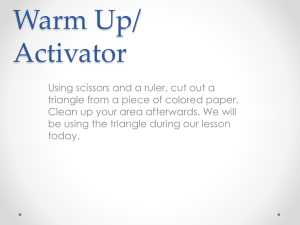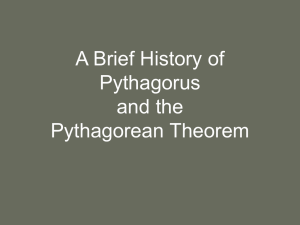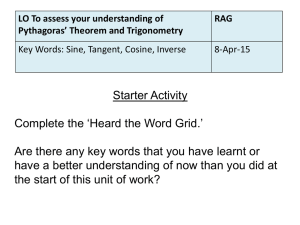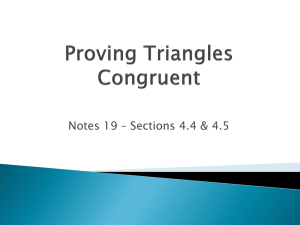Pythagorean Theorem
advertisement
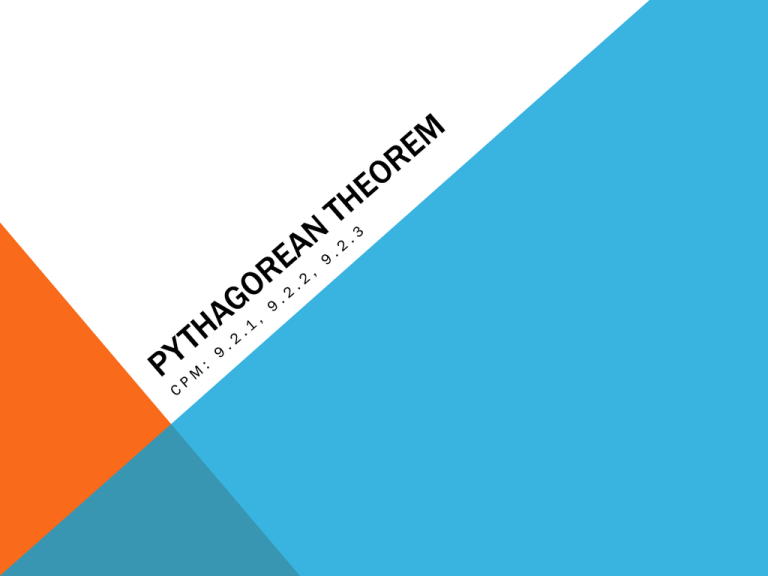
9.2.1 WHAT KIND OF TRIANGLE CAN I MAKE? SIDE LENGTHS AND TRIANGLES Triangles are made of three sides. But can any three lengths make a triangle? Is it possible to predict what kind of triangle – obtuse, acute, or right – three side lengths will make? Today, you will investigate these questions. SIDE LENGTHS AND TRIANGLES When do three lengths form a triangle? Are there special patterns in lengths that always make obtuse triangles? Or are there combinations of lengths that make right or acute triangles? To investigate these questions, you will build triangles and look for patterns that will allow you to predict what kind of triangle three lengths will make. INSTRUCTIONS Carefully cut out each square on the Lesson 9.2.1A Resource Page Using different combinations of three squares, decide if a triangle can be made by connecting the corners of the squares. If you can make a triangle, what kind of triangle is it? The angle on the Lesson 9.2.1B Resource Page can help you determine if an angle is a right (90°) angle. Record the side lengths and areas for each combination of squares you try on the Lesson 9.2.1C SIDE LENGTHS AND TRIANGLES How can we organize our data? What other combinations can we make? What do we expect will happen? How are the sets of three side lengths that did not form triangles different from the sets of side lengths that did form triangles? Be as specific as you can. SIDE LENGTHS AND TRIANGLES Look at the data that you collected for the acute, obtuse, and right triangles. What patterns do you see between the sum of the areas of the two smaller squares and the area of the larger square that formed the triangles in each row? Copy and complete the sentence starters below to summarize the patterns that you see. 1. If three squares have sides that make an acute triangle, then the sum of the areas of the two small squares... > The area of the large square 2. If three squares have sides that make an obtuse triangle, then the sum of the areas of the two small squares... < The area of the large square 3. If three squares have sides that make a right triangle, then the sum of the areas of the two small squares... = to the area of the large square APPLYING YOUR CONCLUSIONS 9-54. Use the patterns you found to predict whether each set of lengths below will form a triangle. If a set will form a triangle, state whether the triangle will be acute, obtuse, or right. Justify your conclusion. a. b. c. d. e. f. 5 cm, 6 cm, and 7 cm 2 cm, 11 cm, 15 cm 10 cm, 15 cm, 20 cm 10 cm, 24 cm, 26 cm 1 cm, 3 cm, 9 cm 2 cm, 10 cm, 11 cm ADDITIONAL CHALLENGE 9-55. Additional Challenge: Lewis wants to build an obtuse triangle. He has already decided to use a square with an area of 81 square units and a square with an area of 25 square units. • What area of square could he use to form the third side of his triangle? Explain your reasoning. • If he makes an acute triangle instead, what size square should he use? Explain your reasoning. 9.2.2 WHAT IS SPECIAL ABOUT A RIGHT TRIANGLE? PYTHAGOREAN THEOREM In Lesson 9.2.1, you saw that for three lengths to form a triangle, they must be related to each other in a special way. Now, you will investigate a special relationship between the side lengths of right triangles. This relationship will allow you to find the length of a missing side. PYTHAGOREAN THEOREM 9-68. Use your patterns from Lesson 9.2.1 to decide if the squares listed below will form a right triangle. • Squares with side lengths 6, 8, and 10 meters • Squares with areas 64 in2, 100 in2, 144 in2 • Two squares with side length 5 feet and a square with area 50 square feet • Explain how you know whether three squares will join at their corners to form a right triangle. Pythagorean Theorem 9-68. Based on your work so far, if you know the area of three squares, you can tell if they will connect at their corners to form a right triangle. But what if you know that a triangle has a right angle? Will the lengths of the sides be related in this way? 9-69 a. On graph paper, form a right angle by drawing one 5-cm length and one 12-cm length as shown above After drawing the two lengths, create a right triangle by connecting the ends of the two lengths with a third side. b. With a ruler, measure the longest side of the triangle in centimeters and label this length. c. Visualize a square connected to each side of the right triangle in part (b). On your paper, sketch a picture like the one below. What is the area of each square? Is the area of the square that is connected to the longest side equal to the sum of the areas of the other two squares. d. Check this pattern with a new example. • Draw a new right angle on the graph paper like you did in part (a). This time, use 9-cm and 12-cm lengths. • Connect the endpoints to create a triangle, and measure the third side. • Create a sketch for this triangle like the one you created in part (c), and find the areas of the squares. Is the area of the square that is connected to the longest side equal to the sum of the other two areas? PYTHAGOREAN THEOREM e. The two shortest sides of a right triangle are called the legs, and the longest side is called the hypotenuse. You previously wrote a statement about the relationship between the areas of squares drawn on the sides of a right triangle. Now use words to describe the relationship between the lengths of the legs and the length of the hypotenuse. PYTHAGOREAN THEOREM 9-70. The relationship you described in part (e) is called the Pythagorean Theorem. It states that in a right triangle, the length of one leg squared plus the length of the other leg squared is equal to the length of the hypotenuse squared. It can be written as an equation like this: (leg A)2 + (leg B)2 = (hypotenuse)2 PYTHAGOREAN THEOREM Use the Pythagorean Theorem to write an equation for each diagram below. Then find each missing area. A. B. C. PYTHAGOREAN THEOREM 9-72. Find the area of the square in each picture below. A. B. C. D. 9.2.3 HOW CAN I FIND THE SIDE LENGTH? UNDERSTANDING SQUARE ROOT You have developed a way to decide if a triangle is a right triangle by looking at the squares of the side lengths of the triangle. If you already know a triangle is a right triangle, how can the Pythagorean Theorem help you determine the length of a leg or the hypotenuse? Today you and your team will develop new ways to find missing lengths of right triangles. UNDERSTANDING SQUARE ROOTS 9-80. Nikita wants to use the area of the squares in the figure at right to find the lengths of the sides of a right triangle. • Find the missing area. • What are the lengths of the legs of the right triangle in Nikita’s diagram? How do you know? • About how long is the hypotenuse? Are you able to find the length exactly? Explain your reasoning. UNDERSTANDING SQUARE ROOTS 9-81. The numbers 36, 64, 4, 16, 100, 144, 121, and 225 are all examples of perfect squares. If each of these numbers represents the number of square units in a square, what is the side length of each square? Why do you think these numbers are called perfect squares? UNDERSTANDING SQUARE ROOTS 9-82. To find the side length of a square with a particular area, you use an operation called the square root. The square root symbol looks like this: . It is also called a radical sign. To find the side length of a square with an area of 81 square units, for example, you would write and would read is as "the square root of 81." Since 9 · 9 = 81, then = 9. Copy each square root expression below. Rewrite each square root as an equivalent expression without the radical sign. Explain your method for finding the square root of these numbers. a. b. c. d. UNDERSTANDING SQUARE ROOTS 9-84. Between which two whole numbers is each of the following square roots listed below? To which whole number do you think it is closer Estimate the value of the square root to the nearest tenth (0.1). You may find it helpful to create a list of the whole numbers from 1 to 17 and their squares to use with this kind of problem. a. b. c. d. e. f. g. Describe your method for estimating the approximate value of a square root when the number is not a perfect square. ADDITIONAL CHALLENGE 9-86. Additional Challenge: Nikita wonders, “What can we say about the square root of a negative number?” Discuss this question with your team. For example, can you find ? Write an explanation of your thinking. Be ready to share your ideas with the class.

